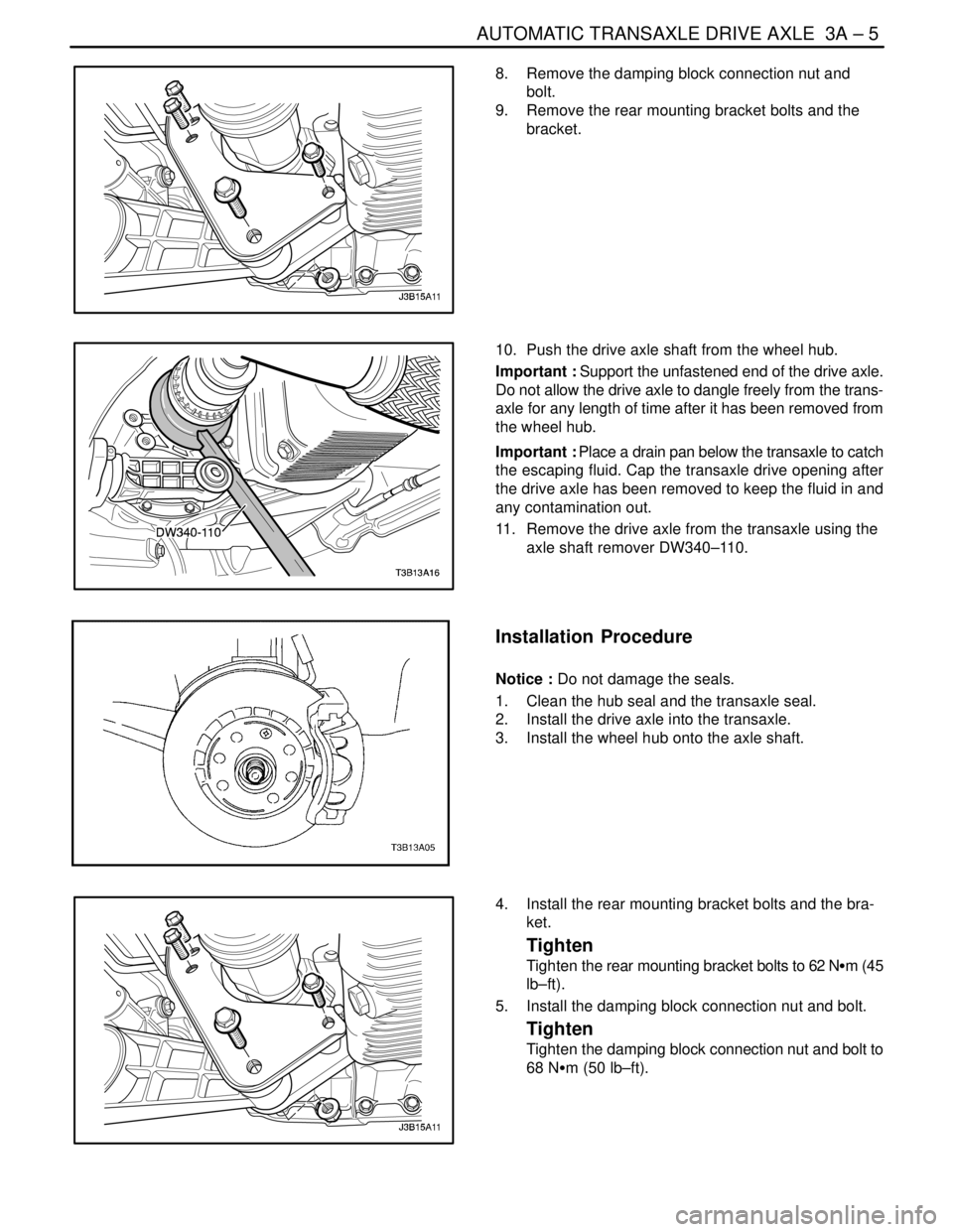Page 973 of 2643

TIRES AND WHEELS 2E – 11
DAEWOO V–121 BL4
pacity, diameter, rim width, offset, and mounting configu-
ration. A wheel of improper size or type may affect wheel
and bearing life, brake cooling, speedometer/odometer
calibration, vehicle ground clearance, and tire clearance
to the body and the chassis. The wheel offset is 49 ± 1 mm
(1.93 ± 0.04 inches). Steel wheels may be identified by a
two– or three–letter code stamped into the rim near the
valve stem. Alloy wheels should have the code, the part
number, and the manufacturer ID cast into the back side.
INFLATION O TIRES
The pressure recommended for any vehicle line is careful-
ly calculated to give a satisfactory ride, handling, tread life,
and load–carrying capacity.
Tire pressure should be checked monthly or before any
extended trip. Check the tires when they are cold, after the
vehicle has sat for 3 hours or more, or has been driven less
than 1 mile. Set the tire pressure to the specifications on
the tire label located on the rear face of the driver’s door.
Tire inflation pressure is also given under ”Tire Size and
Pressure Specifications” in this section.
Valve caps or extensions should be on the valves to keep
dust and water out.
For sustained driving at speeds up to 140 km/h (85 mph),
inflate the tires to the pressure recommended on the tire.
Sustained driving at speeds faster than 140 km/h (85mph), even if permitted by law, is not advised unless the
vehicle has special high–speed tires available from many
tire dealers. Tire pressures may increase as much as 41
kPa (6 psi) when the tires are hot.
Higher than recommended tire pressure can cause
S Hard ride.
S Tire bruising or damage.
S Rapid tread wear at the center of the tire.
Lower than recommended pressure can cause
S Tire squeal on turns.
S Hard steering.
S Rapid and uneven wear on the edges of the tread.
S Tire rim bruises and rupture.
S Tire cord breakage.
S High tire temperatures.
Unequal tire pressures on same axle can cause
S Uneven braking.
S Steering lead.
S Reduced handling.
S Swerve on acceleration.
S Torque steer.
Page 990 of 2643

SECTION : 3A
AUTOMATIC TRANSAXLE DRIVE AXLE
TABLE OF CONTENTS
SPECIFICATIONS3A–1 . . . . . . . . . . . . . . . . . . . . . . . . . .
Fastener Tightening Specifications 3A–1. . . . . . . . . .
SPECIAL TOOLS3A–2 . . . . . . . . . . . . . . . . . . . . . . . . . . .
Special Tools Table 3A–2. . . . . . . . . . . . . . . . . . . . . . . .
COMPONENT LOCATOR3A–2 . . . . . . . . . . . . . . . . . . . .
Front Drive Axle 3A–2. . . . . . . . . . . . . . . . . . . . . . . . . .
MAINTENANCE AND REPAIR3A–4 . . . . . . . . . . . . . . . ON–VEHICLE SERVICE 3A–4. . . . . . . . . . . . . . . . . . . . .
Drive Axle Assembly 3A–4. . . . . . . . . . . . . . . . . . . . . . .
UNIT REPAIR 3A–7. . . . . . . . . . . . . . . . . . . . . . . . . . . . . .
Outer Joint Seal 3A–7. . . . . . . . . . . . . . . . . . . . . . . . . .
Inner Tripot Seal 3A–8. . . . . . . . . . . . . . . . . . . . . . . . . .
GENERAL DESCRIPTION AND SYSTEM
OPERATION3A–10 . . . . . . . . . . . . . . . . . . . . . . . . . . . . .
Front Drive Axle 3A–10. . . . . . . . . . . . . . . . . . . . . . . . . .
SPECIFICATIONS
FASTENER TIGHTENING SPECIFICATIONS
ApplicationNSmLb–FtLb–In
Axle Shaft Caulking Nut300221–
Lower Ball Joint Pinch Bolt and Nut6044–
Tie Rod Nut5541–
Wheel Nuts10074–
Page 993 of 2643
3A – 4IAUTOMATIC TRANSAXLE DRIVE AXLE
DAEWOO V–121 BL4
MAINTENANCE AND REPAIR
ON–VEHICLE SERVICE
DRIVE AXLE ASSEMBLY
Tools Required
KM–507–B Ball Joint Separator
DW340–110 Axle Shaft Remover
Removal Procedure
1. Raise and suitably support the vehicle.
2. Remove the wheels. Refer to Section 2E, Tires
and Wheels.
3. Remove the axle shaft caulking nut. Discard the
nut.
Notice : Use only the recommended tool for separating
the lower ball joint. Failure to use the recommended tool
may cause damage to the ball joint and the seal.
4. Remove the lower ball joint pinch bolt and nut.
5. Separate the steering knuckle from the lower ball
joint using the ball joint separator KM–507–B.
6. Remove the tie rod nut.
Notice : Use only the recommended tool for separating
the tie rod from the knuckle/strut assembly. Failure to use
the recommended tool may cause damage to the knuckle/
strut assembly.
7. Separate the tie rod end using the ball joint separa-
tor KM–507–B.
Page 994 of 2643

AUTOMATIC TRANSAXLE DRIVE AXLE 3A – 5
DAEWOO V–121 BL4
8. Remove the damping block connection nut and
bolt.
9. Remove the rear mounting bracket bolts and the
bracket.
10. Push the drive axle shaft from the wheel hub.
Important : Support the unfastened end of the drive axle.
Do not allow the drive axle to dangle freely from the trans-
axle for any length of time after it has been removed from
the wheel hub.
Important : Place a drain pan below the transaxle to catch
the escaping fluid. Cap the transaxle drive opening after
the drive axle has been removed to keep the fluid in and
any contamination out.
11. Remove the drive axle from the transaxle using the
axle shaft remover DW340–110.
Installation Procedure
Notice : Do not damage the seals.
1. Clean the hub seal and the transaxle seal.
2. Install the drive axle into the transaxle.
3. Install the wheel hub onto the axle shaft.
4. Install the rear mounting bracket bolts and the bra-
ket.
Tighten
Tighten the rear mounting bracket bolts to 62 NSm (45
lb–ft).
5. Install the damping block connection nut and bolt.
Tighten
Tighten the damping block connection nut and bolt to
68 NSm (50 lb–ft).
Page 995 of 2643
3A – 6IAUTOMATIC TRANSAXLE DRIVE AXLE
DAEWOO V–121 BL4
6. Install the tie rod into the knuckle/strut and install
the tie rod nut.
Tighten
Tighten the tie rod nut to 55 NSm (41 lb–ft).
7. Install the lower ball joint pinch bolt and nut.
Tighten
Tighten the lower ball joint pinch bolt and nut to 60
NSm (44 lb–ft).
8. Loosely install a new axle shaft caulking nut. Al-
ways use a new nut.
9. Install the wheels. Loosely install the nuts. Refer to
Section 2E, Tires and Wheels.
10. Lower the vehicle to the floor.
Tighten
Tighten the wheel nuts to 100 NSm (74 lb–ft).
11. Tighten the axle shaft caulking nut to 300 NSm (221
lb–ft).
12. Peen the caulking nut with a punch and a hammer
until the nut is locked into place on the axle shaft
hub.
13. Refill the transaxle fluid to the proper level. Refer to
Section 5A, ZF 4HP 16 Automatic Transaxle.
Page 999 of 2643
3A – 10IAUTOMATIC TRANSAXLE DRIVE AXLE
DAEWOO V–121 BL4
GENERAL DESCRIPTION
AND SYSTEM OPERATION
FRONT DRIVE AXLE
General Description
Drive axles are flexible shaft assemblies that transmit
rotational force from the transaxle to the front–wheel as-
semblies. Each axle assembly consists of an inner and anouter constant–velocity joint connected to an axle shaft.
The inner joint is completely flexible and has the ability to
move in and out. The outer joint is also flexible, but it can-
not move in and out.
The drive axles use one type of outboard joint and one type
of inboard joint. The inboard ends of both drive axles incor-
porate a female spline that installs over a stub shaft pro-
truding from the transaxle.
Page 1000 of 2643

SECTION : 3B
MANUAL TRANSAXLE DRIVE AXLE
TABLE OF CONTENTS
SPECIFICATIONS3B–1 . . . . . . . . . . . . . . . . . . . . . . . . . .
Fastener Tightening Specifications 3B–1. . . . . . . . . .
SPECIAL TOOLS3B–2 . . . . . . . . . . . . . . . . . . . . . . . . . . .
Special Tools Table 3B–2. . . . . . . . . . . . . . . . . . . . . . . .
COMPONENT LOCATOR3B–2 . . . . . . . . . . . . . . . . . . . .
Front Drive Axle 3B–2. . . . . . . . . . . . . . . . . . . . . . . . . .
MAINTENANCE AND REPAIR3B–5 . . . . . . . . . . . . . . .
ON–VEHICLE SERVICE 3B–5. . . . . . . . . . . . . . . . . . . . . Drive Axle Assembly 3B–5. . . . . . . . . . . . . . . . . . . . . . .
UNIT REPAIR 3B–8. . . . . . . . . . . . . . . . . . . . . . . . . . . . . .
Outer Joint Seal 3B–8. . . . . . . . . . . . . . . . . . . . . . . . . .
Inner Tripot Seal 3B–9. . . . . . . . . . . . . . . . . . . . . . . . . .
Cross Groove Joint Seal 3B–11. . . . . . . . . . . . . . . . . . .
GENERAL DESCRIPTION AND SYSTEM
OPERATION3B–13 . . . . . . . . . . . . . . . . . . . . . . . . . . . . .
Front Drive Axle 3B–13. . . . . . . . . . . . . . . . . . . . . . . . .
SPECIFICATIONS
FASTENER TIGHTENING SPECIFICATIONS
ApplicationNSmLb–FtLb–In
Axle Shaft Caulking Nut300221–
Lower Ball Joint Pinch Bolt and Nut6044–
Tie Rod Nut5541–
Wheel Nuts10074–
Page 1004 of 2643
MANUAL TRANSAXLE DRIVE AXLE 3B – 5
DAEWOO V–121 BL4
MAINTENANCE AND REPAIR
ON–VEHICLE SERVICE
DRIVE AXLE ASSEMBLY
Tools Required
KM–507–B Ball Joint Separator
KM–460–A Axle Shaft Remover
Removal Procedure
1. Raise and suitably support the vehicle.
2. Remove the wheels. Refer to Section 2E, Tires and
Wheels.
3. Remove the axle shaft caulking nut. Discard the
nut.
Notice : Use only the recommended tool for separating
the lower ball joint. Failure to use the recommended tool
may cause damage to the ball joint and the seal.
4. Remove the lower ball joint pinch bolt and nut.
5. Separate the steering knuckle from the lower ball
joint using the ball joint separator KM–507–B.
6. Remove the tie rod nut.
Notice : Use only the recommended tool for separating
the tie rod from the knuckle/strut assembly. Failure to use
the recommended tool may cause damage to the knuckle/
strut assembly.
7. Separate the tie rod end using the ball joint separa-
tor KM–507–B.